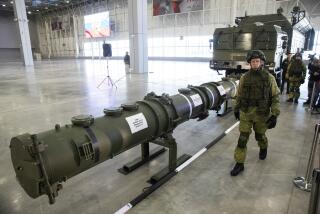As Treaty Dies, Missile Site Born
- Share via
WASHINGTON — The death of the 1972 Antiballistic Missile Treaty on Thursday cleared the way to begin digging interceptor silos in Alaska and for futuristic missile tests barred by the pact.
A groundbreaking ceremony is scheduled Saturday at Ft. Greely, Alaska, where President Bush plans a test facility that he hopes could also serve as an emergency defense by September 2004.
And Thursday night, an interceptor rocket fired from a Navy ship off Hawaii slammed into a dummy warhead in space in a success for a troubled part of the U.S. missile defense program.
The exercise showed that a rocket guided by a warship’s radar system can knock down a medium- or long-range missile under controlled conditions. Pentagon officials said the test wasn’t meant to be realistic but would help gather data to guide further development of ship-based antimissile systems.
The missile test would have been legal under the treaty, and the timing of the test was “sheer coincidence,” said Chris Taylor, a Missile Defense Agency spokesman.
No coincidence, however, was the start of earthwork for silos to house future interceptors at Ft. Greely, about 100 miles southeast of Fairbanks. Breaking ground for a national missile defense base was barred by the treaty.
White House spokesman Ari Fleischer said Thursday that Bush was committed to deploying a missile defense “as soon as possible to protect the American people and our deployed forces from the growing risks of terrorist nations or terrorists possessing weapons of mass destruction.”
More to Read
Sign up for Essential California
The most important California stories and recommendations in your inbox every morning.
You may occasionally receive promotional content from the Los Angeles Times.










